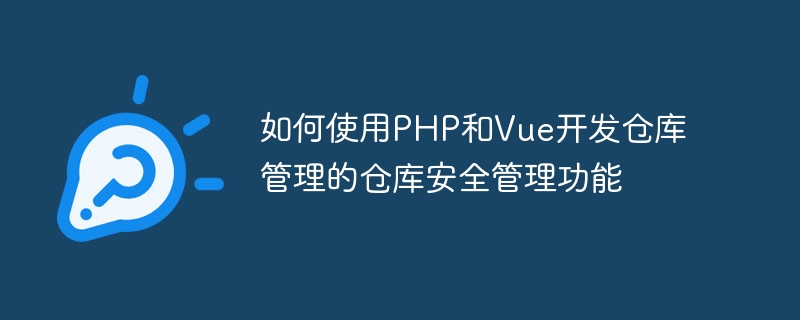
如何使用PHP和Vue开发仓库管理的仓库安全管理功能
在当前市场竞争日益激烈的环境下,仓库管理对企业的运营至关重要。为了确保仓库的顺利运作和安全管理,许多企业借助技术手段进行系统化的管理。本文将介绍使用PHP和Vue开发仓库安全管理功能的具体方法,并提供代码示例。
步骤一:搭建开发环境
要开始使用PHP和Vue开发仓库安全管理功能,首先需要搭建相应的开发环境。你需要在你的电脑上安装PHP服务器和Vue开发工具,推荐使用XAMPP作为PHP服务器和Visual Studio Code作为Vue开发工具。确保你已经正确安装了这些软件,并能够成功启动PHP服务器和Vue开发工具。
步骤二:创建数据库和数据表
在PHP和Vue开发仓库管理功能之前,我们需要创建相应的数据库和数据表来存储相关的数据。打开phpMyAdmin或其他数据库管理工具,创建一个新的数据库,并在该数据库中创建一个名为"warehouses"的数据表。
数据表"warehouses"的结构如下:
CREATE TABLE `warehouses` ( `id` int(11) NOT NULL AUTO_INCREMENT, `name` varchar(255) NOT NULL, `location` varchar(255) NOT NULL, `security_level` int(11) NOT NULL, PRIMARY KEY (`id`) );
步骤三:编写PHP后端代码
接下来,我们将编写PHP后端代码来处理仓库管理的相关操作。在你的项目目录下创建一个名为"api"的文件夹,并在该文件夹下创建一个名为"warehouses.php"的PHP文件。在该文件中,我们将实现仓库的增删改查功能。
在"warehouses.php"中,我们需要使用PHP的"mysqli"扩展库来连接数据库,并编写相关的API。以下是"warehouses.php"的示例代码:
<?php
$db_host = "localhost"; // 数据库主机名
$db_user = "root"; // 数据库用户名
$db_password = ""; // 数据库密码
$db_name = "your_database_name"; // 数据库名称
// 连接数据库
$conn = new mysqli($db_host, $db_user, $db_password, $db_name);
// 检查连接是否成功
if ($conn->connect_error) {
die("Connection failed: " . $conn->connect_error);
}
// 处理GET请求,获取仓库列表
if ($_SERVER["REQUEST_METHOD"] === "GET") {
$result = $conn->query("SELECT * FROM warehouses");
$warehouses = [];
while ($row = $result->fetch_assoc()) {
$warehouses[] = $row;
}
echo json_encode($warehouses);
}
// 处理POST请求,添加新的仓库
if ($_SERVER["REQUEST_METHOD"] === "POST") {
$name = $_POST["name"];
$location = $_POST["location"];
$security_level = $_POST["security_level"];
$sql = "INSERT INTO warehouses (name, location, security_level) VALUES ('$name', '$location', '$security_level')";
if ($conn->query($sql) === TRUE) {
echo "New warehouse added successfully";
} else {
echo "Error: " . $sql . "<br>" . $conn->error;
}
}
// 处理DELETE请求,删除仓库
if ($_SERVER["REQUEST_METHOD"] === "DELETE") {
$id = $_GET["id"];
$sql = "DELETE FROM warehouses WHERE id=$id";
if ($conn->query($sql) === TRUE) {
echo "Warehouse deleted successfully";
} else {
echo "Error: " . $sql . "<br>" . $conn->error;
}
}
// 关闭数据库连接
$conn->close();
?>步骤四:编写Vue前端代码
现在,我们将编写Vue前端代码来与后端交互,并展示仓库的相关信息。在你的项目目录下创建一个名为"src"的文件夹,并在该文件夹下创建一个名为"Warehouse.vue"的Vue组件文件。
在"Warehouse.vue"中,我们将使用Vue的"axios"库来发送HTTP请求,并渲染仓库列表。以下是"Warehouse.vue"的示例代码:
<template>
<div>
<h2>Warehouse List</h2>
<ul>
<li v-for="warehouse in warehouses" :key="warehouse.id">
<span>{{ warehouse.name }}</span>
<span>{{ warehouse.location }}</span>
<span>{{ warehouse.security_level }}</span>
<button @click="deleteWarehouse(warehouse.id)">Delete</button>
</li>
</ul>
<h2>Add New Warehouse</h2>
<form @submit.prevent="addWarehouse">
<input type="text" v-model="name" placeholder="Name" required>
<input type="text" v-model="location" placeholder="Location" required>
<input type="number" v-model="security_level" placeholder="Security Level" required>
<button type="submit">Add</button>
</form>
</div>
</template>
<script>
import axios from 'axios';
export default {
data() {
return {
warehouses: [],
name: '',
location: '',
security_level: 0
};
},
methods: {
fetchWarehouses() {
axios.get('api/warehouses.php')
.then(response => {
this.warehouses = response.data;
})
.catch(error => {
console.log(error);
});
},
addWarehouse() {
axios.post('api/warehouses.php', {
name: this.name,
location: this.location,
security_level: this.security_level
})
.then(response => {
console.log(response.data);
this.fetchWarehouses();
})
.catch(error => {
console.log(error);
});
},
deleteWarehouse(id) {
axios.delete(`api/warehouses.php?id=${id}`)
.then(response => {
console.log(response.data);
this.fetchWarehouses();
})
.catch(error => {
console.log(error);
});
}
},
mounted() {
this.fetchWarehouses();
}
}
</script>步骤五:运行应用程序
现在,我们已经完成了使用PHP和Vue开发仓库管理的仓库安全管理功能的代码编写。你可以使用命令行进入你的项目目录,并运行以下命令启动应用程序:
npm run serve
接下来,打开你的浏览器,访问"http://localhost:8080",你将看到仓库列表和添加仓库的表单。当你添加或删除仓库时,页面将实时更新。通过这种方式,你可以实现仓库的安全管理。
以上是如何使用PHP和Vue开发仓库管理的仓库安全管理功能的详细内容。更多信息请关注PHP中文网其他相关文章!



